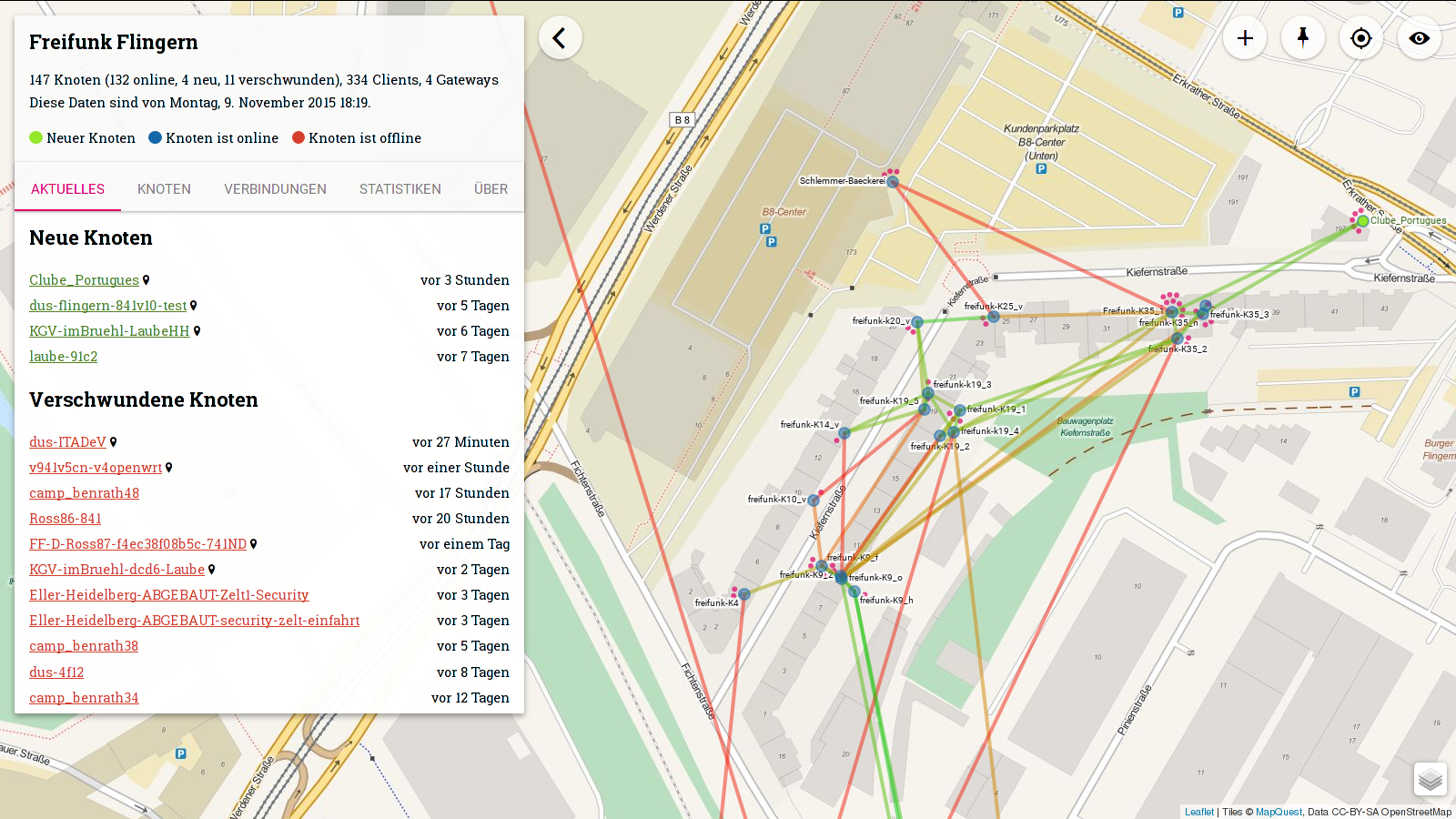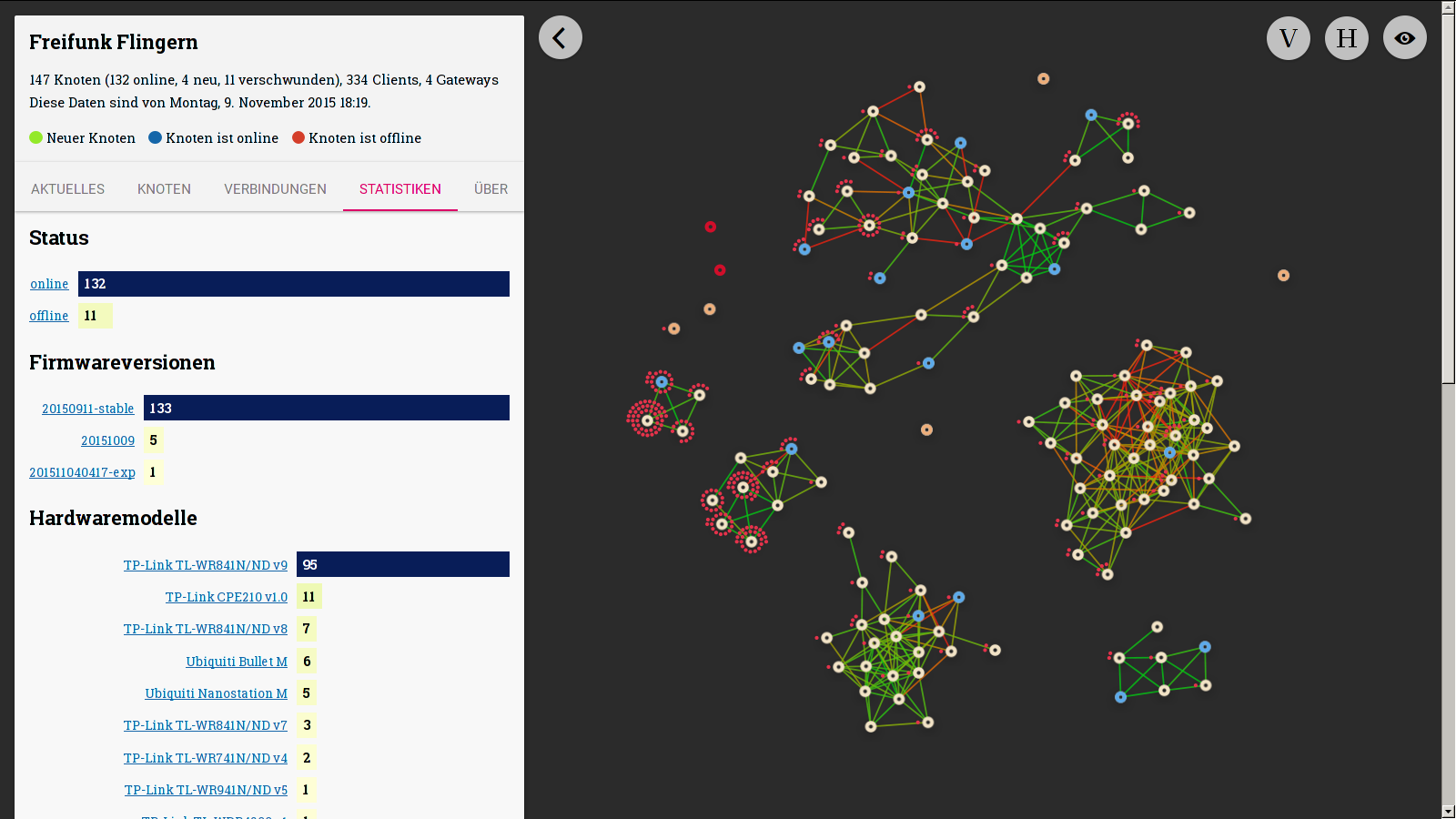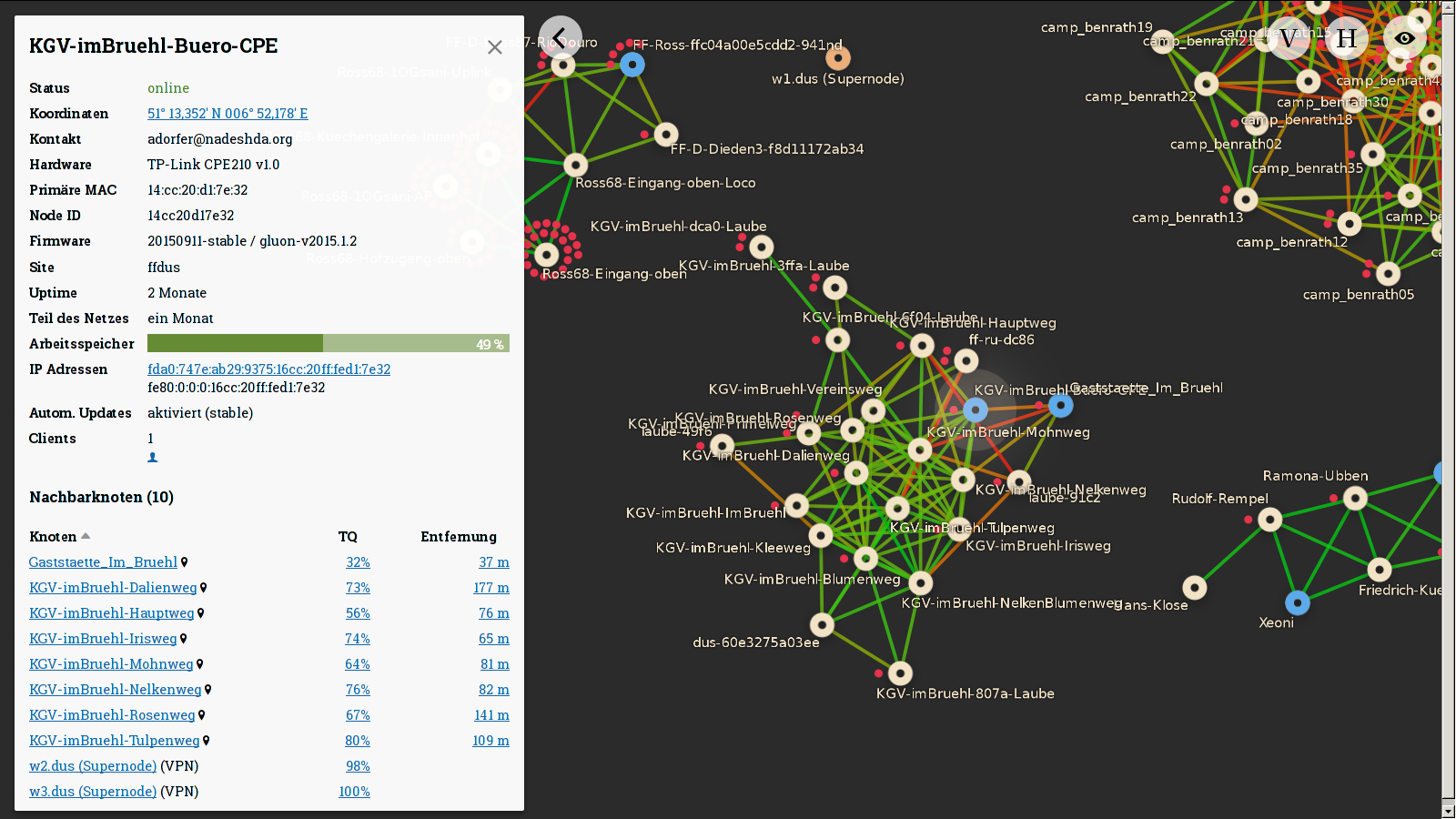Meshviewer is a frontend for ffmap-backend.
This is a fork of the original Meshviewer project, which is not maintained by its creator anymore. The aim is to bring some organization into the development of Meshviewer after the discontinuation of the original project. There is no stable release cycle at the moment. Please use the master branch and update your installation regularly.
Copy config.json.example to build/config.json and change it to match your community.
dataPath must contain one or more strings pointing to a directory containing
nodes.json and graph.json (both are generated by
ffmap-backend). Don't forget the
trailing slash! Data may be served from a different domain with CORS enabled.
Also, GZip will greatly reduce bandwidth consumption.
Change this to match your communities' name. It will be used in various places.
This affects the initial scale of the map. Greater values will show a larger area. Values like 1.0 and 0.5 might be good choices.
Setting this to false will hide contact information for nodes.
Nodes being online for less than maxAge days are considered "new". Likewise, nodes being offline for less than than maxAge days are considered "lost".
A list of objects describing map layers. Each object has at least name
property and optionally url and config properties. If no url is supplied
name is assumed to name a
Leaflet-provider.
This option allows to show client statistics depending on following case-sensitive parameters:
namecaption of statistics segment in infoboxhrefabsolute or relative URL to statistics imagethumbnailabsolute or relative URL to thumbnail image, can be the same likehrefcaptionis shown, ifthumbnailis not present (no thumbnail in infobox)
To insert current node-id in either href, thumbnail or caption
you can use the case-sensitive template string {NODE_ID}.
Examples for nodeInfos:
"nodeInfos": [
{ "name": "Clientstatistik",
"href": "nodes/{NODE_ID}.png",
"thumbnail": "nodes/{NODE_ID}.png",
"caption": "Knoten {NODE_ID}"
},
{ "name": "Uptime",
"href": "nodes_uptime/{NODE_ID}.png",
"thumbnail": "nodes_uptime/{NODE_ID}.png",
"caption": "Knoten {NODE_ID}"
}
]
In order to have statistics images available, you have to run the backend with parameter --with-rrd or generate them in other ways.
This option allows to show global statistics on statistics page depending on following case-sensitive parameters:
namecaption of statistics segment in infoboxhrefabsolute or relative URL to statistics imagethumbnailabsolute or relative URL to thumbnail image, can be the same likehrefcaptionis shown, ifthumbnailis not present (no thumbnail in infobox)
In contrast to nodeInfos there is no template substitution in href, thumbnail or caption.
Examples for globalInfos:
"globalInfos": [
{ "name": "Wochenstatistik",
"href": "nodes/globalGraph.png",
"thumbnail": "nodes/globalGraph.png",
"caption": "Bild mit Wochenstatistik"
},
{ "name": "Jahresstatistik",
"href": "nodes/globalGraph52.png",
"thumbnail": "nodes/globalGraph52.png",
"caption": "Bild mit Jahresstatistik"
}
]
In order to have global statistics available, you have to run the backend with parameter --with-rrd (this only creates globalGraph.png) or generate them in other ways.
In lib/map.js you can change the colors and radius for nodes in different states:
- iconNew: Nodes that are online for less than maxAge days (default: green, radius: 6)
- iconOnline: online for more than
maxAgedays (default blue, radius: 6) - iconAlert: nodes offline less than 8 Hours (default: blinking red, radius: 5)
- iconLost: nodes being offline for less than than
maxAgedays (default: grey, radius: 5) - iconOffline: offline for more than
maxAgedays up to the maximum prune time of the backend (default: grey, radius: 3)
In this array name definitions for site statistics and node info can be saved. This requires one object for each site code. This object must contain:
sitethe site codenamethe defined written name for this site code
If neither siteNames nor showSites are set, site statistics and node info won't be displayed
Example for siteNames:
"siteNames": [
{ "site": "ffhl", "name": "Lübeck" },
{ "site": "ffgt", "name": "Gothamcity" },
{ "site": "ffal", "name": "Atlantis" }
]
Consider using a precompiled tarball of the latest and greatest master commit
- npm
- bower
- grunt-cli
- Sass (>= 3.2)
Install npm and Sass with your package-manager. On Debian-like systems run:
sudo apt-get install git npm nodejs-legacy ruby-sass
or if you have bundler you can install ruby-sass simply via bundle install
Execute these commands on your server as a normal user to prepare the dependencies:
git clone https://github.com/plumpudding/meshviewer.git
cd meshviewer
npm install
npm install grunt-cli
Just run the following command from the meshviewer directory:
node_modules/.bin/grunt
This will generate build/ containing all required files.
Place your config.json in the build/ directory. Now just copy build/ into your servers document-home (e.g. /var/www/meshviewer/ or /srv/http/meshviewer/).
Contributions are generally welcome. Please make sure your request meets all the following criteria:
- The changes don't drastically decrease performance and are implemented with weak clients (such as smartphones) in mind.
- It is impossible to archieve the same result without the changes. Simplifications of existing features are not likely to be accepted.
- The code is not overcomplicated and uses a style similar to other parts of the codebase.
If you really want a feature don't be afraid to ask. We will make a decision for the individual case or find a reasonable compromise.
If you modify the source be sure to update the links in lib/about.js to match your modified version.


